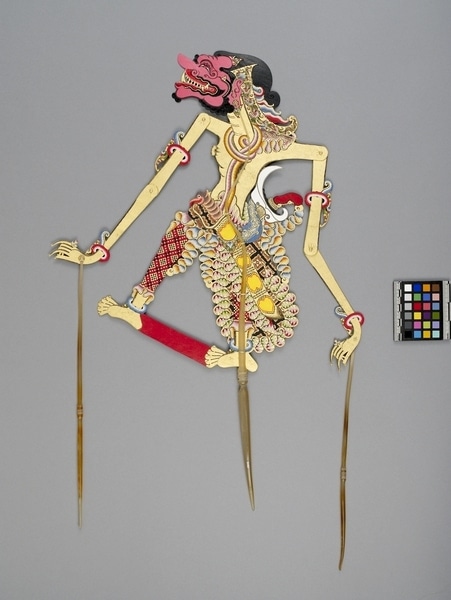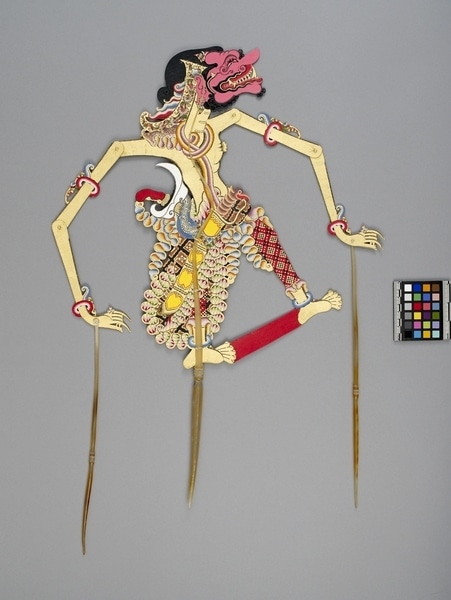Shadow Puppet Item Number: 1568/2 from the MOA: University of British Columbia


Description
Wayang kulit shadow puppet from Ramayana series: Kalamarica character. Two-dimensional figure with articulated shoulders and elbows; has a man-like body and a vibrant pink face with long, bumpy nose, small beard, and three fangs. Rest of skin is painted gold; clothing at legs is red with gold and white checkered diamond patterns; clothing at waist is a cloth with gold green and pink edging in back and blue, white and orange at front. Also at waist is a sword with a bird-shaped hilt in a yellow and beige scabbard. A decoration with gold ground and floral motif runs from side of head down to shoulder. There are bands at wrists and biceps in pink and blue at ankles. A sash in orange, yellow, pink and white goes around neck and down front. The arms are controlled by horn rods that are attacked to the hands; another horn rod is split down the middle and has height of the puppet between its two sides.
History Of Use
Wayang kulit shadow play is over a thousand years old. It is thought to be derived from the leather shadow puppetry of southern India, like tholu bommalata, which came to Java with the spread of Hinduism in the first millennium. In Java--part of the largely Islamic Republic of Indonesia--this highly distinctive form of shadow puppetry is valued as a pusaka, a sacred treasure of the royal court of Yogyakarta. The plays are performed to mark special occasions, such as birthdays, marriages, and religious events. They have also been adapted for television and for public education campaigns. At the heart of all performances is the dhalang, the leading artist, puppeteer and gamelan orchestra leader. With immense energy, drama, humour and creativity, the dhalang is responsible for manipulating the puppets; for interpreting their personalities and gestures; for speaking in their particular voices; for narrating the story and for conducting the gamelan orchestra— gongs, xylophones, drums, bowls, vocals, strings. When the play is about to begin, the dhalang places one of his gunungan or kayon—a large leaf-shaped shadow puppet-form representing a tree of life or sacred mountain—in the centre of the screen to separate the opposing groups of puppets and to announce that the cosmic order is in balance. Part way through the play, chaos descends when the four clown characters--Semar and his sons, Bagong, Gareng and Petruk--make an entry. They enliven and delight the audience with their crude and comic behaviours, jokes and songs.
Item History
- Made in Java, Indonesia before 1993
- Owned by Dominique Major before January 25, 1993
- Received from Dominique Major (Seller) and Museum of Anthropology Shop Volunteers (Funding source) on January 25, 1993
What
- Name
- Shadow Puppet
- Identification Number
- 1568/2
- Type of Item
- puppet
- Material
- water buffalo skin, metal ?, paint and water buffalo horn
- Overall
- height 77.0 cm, width 22.5 cm, depth 1.7 cm
Who
- Culture
- Javanese
- Previous Owner
- Dominique Major
- Received from
- Dominique Major (Seller) and Museum of Anthropology Shop Volunteers (Funding source)
Where
- Holding Institution
- MOA: University of British Columbia
- Made in
- Java, Indonesia
When
- Creation Date
- before 1993
- Ownership Date
- before January 25, 1993
- Acquisition Date
- on January 25, 1993
Other
- Condition
- excellent
- Accession Number
- 1568/0002